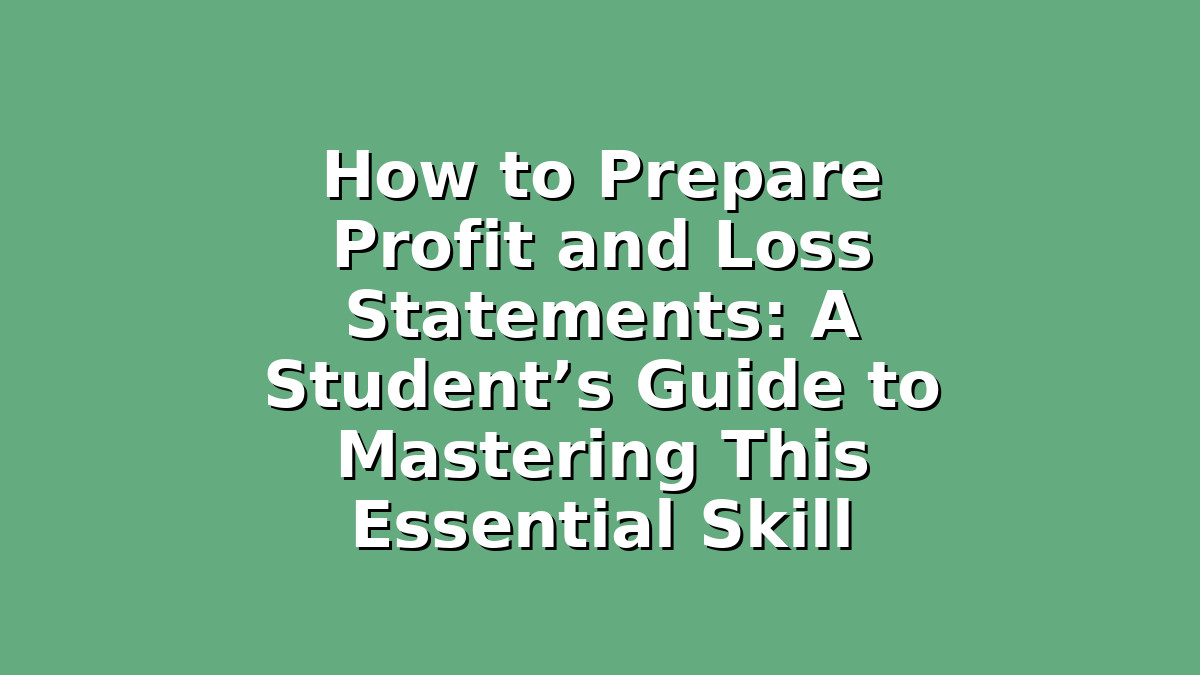Preparing a Profit and Loss (P&L) statement is a fundamental skill in accounting and finance that every student should master, especially if you’re preparing for exams or looking to build a strong foundation in business studies. Understanding how to create and interpret these statements not only helps you excel academically but also equips you with practical knowledge valuable in real-world business scenarios.
In this article, we’ll break down the process of preparing a Profit and Loss statement with clear, step-by-step advice tailored to students. Whether you’re tackling accounting assignments, preparing for an exam, or simply want to improve your understanding, these tips will guide you through the essentials of P&L statements with confidence.
—
Introduction to Profit and Loss Statements
A Profit and Loss statement, sometimes called an income statement, summarizes a business’s revenues, costs, and expenses over a specific period, usually a month, quarter, or year. Its primary purpose is to show whether a company made a profit or incurred a loss during that time.
For students, the P&L statement can seem daunting at first due to the technical terminology and calculations involved. However, once you grasp the structure and logic behind it, preparing one becomes a straightforward task. The key is understanding the components—revenues, cost of goods sold (COGS), gross profit, operating expenses, and net profit—and how they fit together.
—
Section 1: Understand the Core Components and Terminology
Before diving into preparation, start by familiarizing yourself with the basic terms and components of a Profit and Loss statement. This foundational knowledge is crucial for completing your exams confidently.
– Revenue (Sales): This is the total income generated from selling goods or services before any costs are deducted. Always make sure to distinguish between gross revenue and net revenue (after returns or discounts).
– Cost of Goods Sold (COGS): This includes the direct costs involved in producing the goods or services sold, such as materials and labor. Understanding COGS helps you calculate the gross profit.
– Gross Profit: Calculated as Revenue minus COGS, this figure shows how much money the company made from its core business before accounting for other expenses.
– Operating Expenses: These are indirect costs required to run the business, such as rent, utilities, salaries, and marketing expenses.
– Net Profit (or Net Loss): This is the bottom line—gross profit minus operating expenses and other costs like taxes and interest. A net profit means the business is profitable, while a net loss indicates more money was spent than earned.
Study Tip: Create flashcards with these terms and their definitions. Regularly quiz yourself to reinforce your understanding, as many exam questions will test your ability to identify and explain these components.
—
Section 2: Practice Step-by-Step Preparation of a P&L Statement
Once you’re comfortable with the terminology, it’s time to practice the actual preparation. Break down the process into manageable steps to avoid feeling overwhelmed.
1. Gather the data: For exam practice, you’ll usually be provided with figures for sales, expenses, and other relevant information. Organize this data clearly on your paper or spreadsheet.
2. Calculate Revenue: Start with total sales or service revenue. If discounts or returns are given, subtract them to find the net revenue.
3. Determine COGS: Add up all direct costs related to producing what was sold. Remember to include materials, labor, and any manufacturing overhead if applicable.
4. Calculate Gross Profit: Subtract the COGS from the revenue. This shows how much money is left before operating expenses.
5. List Operating Expenses: Add up all indirect expenses such as administration, marketing, and rent.
6. Find Net Profit: Deduct operating expenses from the gross profit. Make sure to include any additional expenses like taxes or interest if provided.
7. Review and double-check: Accuracy is crucial. Recheck your math and ensure every figure is in the right place.
Study Tip: Practice with multiple sample problems from textbooks or online resources. Time yourself to simulate exam conditions, which helps improve speed and accuracy.
—
Section 3: Use Study Strategies to Enhance Your Understanding and Retention
Preparing P&L statements for exams is not just about memorizing steps—it’s about understanding concepts deeply and applying them under pressure. Here are some strategies to help:
– Visual Aids: Use charts and diagrams to visualize the flow from revenue to net profit. Drawing a simple “profit ladder” can help you see how each component impacts the final figure.
– Group Study Sessions: Explaining the process to peers or working through problems together can deepen your understanding. Teaching others is one of the best ways to reinforce what you’ve learned.
– Summarize with Mnemonics: Create easy-to-remember phrases for the order of calculations, such as “R–C–G–O–N” (Revenue, COGS, Gross profit, Operating expenses, Net profit).
– Connect Theory to Real Life: Try to relate concepts to real companies or your personal experiences. For example, think about how a small business you know might track sales and expenses.
– Ask for Feedback: If you’re completing practice questions, seek feedback from teachers or tutors. They can help identify errors and suggest improvements.
– Use Online Resources: Websites like Khan Academy, accounting blogs, or YouTube tutorials offer step-by-step videos and explanations that can clarify tricky parts.
—
Conclusion
Mastering how to prepare Profit and Loss statements is a vital step in your academic and professional journey in business and accounting. By understanding the key components, practicing the preparation steps methodically, and employing effective study strategies, you’ll build confidence and improve your exam performance.
Remember, like any skill, proficiency comes with consistent practice and a positive mindset. Don’t get discouraged by initial challenges—instead, view them as opportunities to learn and grow. With dedication and the right approach, you’ll not only excel in your exams but also gain valuable knowledge to apply in the future.
Stay motivated, keep practicing, and soon preparing Profit and Loss statements will feel like second nature!
—

Responses